Are you torn between Hoang Su Phi and Sapa for your Vietnam adventure, specifically for experiencing terraced fields and trekking? SIXT.VN is here to guide you in choosing the perfect destination for your travel style and preferences, ensuring a memorable journey. By understanding the unique aspects of each location, you can make an informed decision and potentially discover hidden gems, cultural experiences, and breathtaking landscapes.
1. Introduction: Hoang Su Phi vs. Sapa – A Terraced Field & Trekking Dilemma
When planning a trip to Northern Vietnam, the stunning terraced rice fields often top the list of must-see attractions. Two destinations stand out: Sapa and Hoang Su Phi. Both offer incredible landscapes and trekking opportunities, but they cater to different travel styles. Sapa is the more established tourist hub, while Hoang Su Phi provides a more off-the-beaten-path experience. To help you decide which is best for you, let’s explore their key differences and similarities, ensuring you choose the perfect backdrop for your Vietnam adventure. According to a report by the Vietnam National Administration of Tourism in 2023, both regions contribute significantly to the tourism sector, but they offer distinct experiences (Vietnam National Administration of Tourism, 2023).
2. Understanding Sapa: The Popular Choice
2.1. Sapa’s Terraced Fields: A Tourist Magnet
Sapa’s terraced fields are iconic. Carved into the rolling hills, they create a mesmerizing landscape, especially during the planting and harvesting seasons. Muong Hoa Valley is particularly famous, offering breathtaking views. Sapa’s appeal is undeniable, drawing visitors worldwide with its well-established tourist infrastructure, variety of accommodations, and easy accessibility.
2.2. Trekking in Sapa: Options for Every Level
Trekking in Sapa is well-organized, with routes ranging from easy strolls through villages to challenging climbs up Fansipan, the highest peak in Indochina. Many treks are guided, providing insight into the local culture and history.
2.3. Sapa’s Tourism Infrastructure: Convenience and Accessibility
Sapa is a well-developed tourist destination. You’ll find a wide range of hotels, restaurants, and tour operators catering to various budgets. Getting to Sapa is relatively easy, with overnight buses and the option of the train to Lao Cai followed by a bus ride.
2.4. Sapa’s Cultural Scene: A Blend of Tradition and Tourism
Sapa is home to several ethnic minority groups, including the Hmong, Dao, and Tay. While tourism has impacted their traditional way of life, you can still experience their culture through homestays, markets, and traditional crafts. Be aware of the potential for tourist traps and prioritize ethical interactions.
3. Discovering Hoang Su Phi: The Untouched Gem
3.1. Hoang Su Phi’s Terraced Fields: Raw Beauty and Authenticity
Hoang Su Phi’s terraced fields are often described as more raw and authentic than Sapa’s. The landscapes are equally stunning, but the area is less crowded, offering a more immersive experience. The fields are spread across six communes: Ban Luoc, San Sa Ho, Ban Phung, Ho Thau, Nam Ty, and Thong Nguyen, each with unique characteristics.
3.2. Trekking in Hoang Su Phi: A Challenge for Adventurers
Trekking in Hoang Su Phi is more challenging than in Sapa. The trails are less developed, and you’ll likely need a local guide. However, the reward is a more authentic experience, with fewer tourists and closer interactions with the local communities.
3.3. Hoang Su Phi’s Tourism Infrastructure: Simplicity and Local Charm
Hoang Su Phi’s tourism infrastructure is less developed than Sapa’s. Accommodation options are limited, mainly consisting of homestays and guesthouses. While this means fewer amenities, it also offers a more genuine cultural experience and contributes directly to the local economy.
3.4. Hoang Su Phi’s Cultural Scene: Immersing in Local Life
Hoang Su Phi is home to various ethnic minority groups, including the Ha Nhi, Dao, and Nung. The area is less touristy than Sapa, allowing for more authentic cultural experiences. You can visit local markets, participate in traditional ceremonies, and learn about their unique customs and way of life.
4. A Head-to-Head Comparison: Sapa vs. Hoang Su Phi
To help you make the best decision, let’s break down the key differences between Sapa and Hoang Su Phi in a table format:
| Feature | Sapa | Hoang Su Phi |
|---|---|---|
| Terraced Fields | Iconic, well-maintained, more crowded | Raw, authentic, less crowded |
| Trekking | Organized, various levels, guided tours | Challenging, less developed trails, local guides recommended |
| Infrastructure | Well-developed, wide range of options | Basic, homestays and guesthouses |
| Accessibility | Easy, overnight buses and trains | More difficult, requires more travel time |
| Cultural Scene | Blend of tradition and tourism | Authentic, less touristy |
| Crowds | High | Low |
| Cost | Generally more expensive | Generally less expensive |
| Experience Level | Suitable for all levels | More suited for experienced travelers |
5. Key Considerations for Your Trip
5.1. Your Travel Style: What Are You Looking For?
- Comfort and Convenience: If you prefer well-established amenities and easy access, Sapa is a better choice.
- Adventure and Authenticity: If you’re seeking a more off-the-beaten-path experience and don’t mind roughing it a bit, Hoang Su Phi is ideal.
- Cultural Immersion: Both offer cultural experiences, but Hoang Su Phi provides a more authentic glimpse into local life due to its lower tourist density.
5.2. Best Time to Visit: Planning Around the Harvest Seasons
The best time to visit both Sapa and Hoang Su Phi is during the rice planting and harvesting seasons:
- Planting Season (May-June): The fields are filled with water, creating stunning reflections of the sky.
- Harvest Season (September-October): The fields turn golden yellow, offering a breathtaking panorama.
5.3. Trekking Difficulty: Assessing Your Fitness Level
- Sapa: Offers treks for all fitness levels, from easy walks to challenging climbs.
- Hoang Su Phi: Requires a higher level of fitness due to the rugged terrain and less developed trails.
5.4. Budget Considerations: Balancing Cost and Experience
- Sapa: Generally more expensive due to its established tourism infrastructure.
- Hoang Su Phi: More budget-friendly, with cheaper accommodation and food options.
6. Sapa: A Deep Dive into the “Town in the Clouds”
6.1. Must-See Attractions in Sapa
Sapa boasts several iconic attractions that are well worth a visit:
- Fansipan Peak: Conquer the “Roof of Indochina” by cable car or a challenging trek.
- Muong Hoa Valley: Admire the stunning terraced fields and ancient rock carvings.
- Cat Cat Village: Experience the culture of the Black Hmong people.
- Ham Rong Mountain: Enjoy panoramic views of Sapa town and the surrounding mountains.
- Sapa Market: Immerse yourself in local life and shop for traditional handicrafts.
6.2. Trekking Routes in Sapa: From Gentle Strolls to Challenging Climbs
Sapa offers a variety of trekking routes to suit all fitness levels:
- Easy: Cat Cat Village, Ta Phin Village
- Moderate: Lao Chai – Ta Van Village, Giang Ta Chai Village
- Challenging: Fansipan Peak, Sapa – Y Linh Ho – Lao Chai – Ta Van – Giang Ta Chai – Sapa (multi-day trek)
6.3. Accommodation Options in Sapa: From Budget to Luxury
Sapa offers a wide range of accommodation options:
- Budget: Hostels, guesthouses, homestays
- Mid-Range: Hotels, boutique hotels
- Luxury: Resorts, high-end hotels
6.4. Sapa’s Culinary Delights: A Taste of the Highlands
Sapa’s cuisine is a highlight for many visitors. Don’t miss these local specialties:
- Thang Co: A traditional horse meat stew.
- Black Chicken: A unique local breed with flavorful meat.
- Grilled Dishes: A variety of meats and vegetables grilled over charcoal.
- Bamboo Rice: Rice cooked in a bamboo tube.
- Salmon Hotpot: Fresh salmon in a flavorful broth.
7. Hoang Su Phi: Unveiling the “Hidden Rice Bowl”
7.1. Must-See Attractions in Hoang Su Phi
Hoang Su Phi offers a more off-the-beaten-path experience with its hidden gems:
- Ban Luoc Terraced Fields: Known for their unique shape and stunning beauty.
- San Sa Ho Terraced Fields: Offers panoramic views of the surrounding mountains.
- Ban Phung Terraced Fields: The highest terraced fields in Hoang Su Phi.
- Ho Thau Terraced Fields: A remote and peaceful area with traditional villages.
- Nam Ty Terraced Fields: Offers a glimpse into the local Ha Nhi culture.
- Thong Nguyen Terraced Fields: Discover the secret rice fields of Thong Nguyen.
7.2. Trekking Routes in Hoang Su Phi: An Adventure for Experienced Trekkers
Trekking in Hoang Su Phi is more challenging but rewarding:
- Ban Luoc – Ban Phung: A challenging trek through stunning terraced fields.
- San Sa Ho – Nam Ty: A moderate trek with opportunities to experience local culture.
- Ho Thau – Thong Nguyen: A remote trek through pristine landscapes.
7.3. Accommodation Options in Hoang Su Phi: Authentic Homestays and Guesthouses
Accommodation in Hoang Su Phi is more basic but offers a genuine cultural experience:
- Homestays: Stay with local families and experience their way of life.
- Guesthouses: Simple and affordable accommodation options.
- Ecolodges: Offering a more comfortable stay with sustainable practices.
7.4. Hoang Su Phi’s Culinary Delights: A Taste of Local Flavors
Hoang Su Phi’s cuisine is simple but delicious, with fresh local ingredients:
- Sticky Rice: A staple food in the region.
- Corn Cake: A sweet and savory snack.
- Hill Chicken: A flavorful local breed.
- Vegetable Dishes: Fresh and organic vegetables from local farms.
- Local Rice Wine: A traditional drink made from rice.
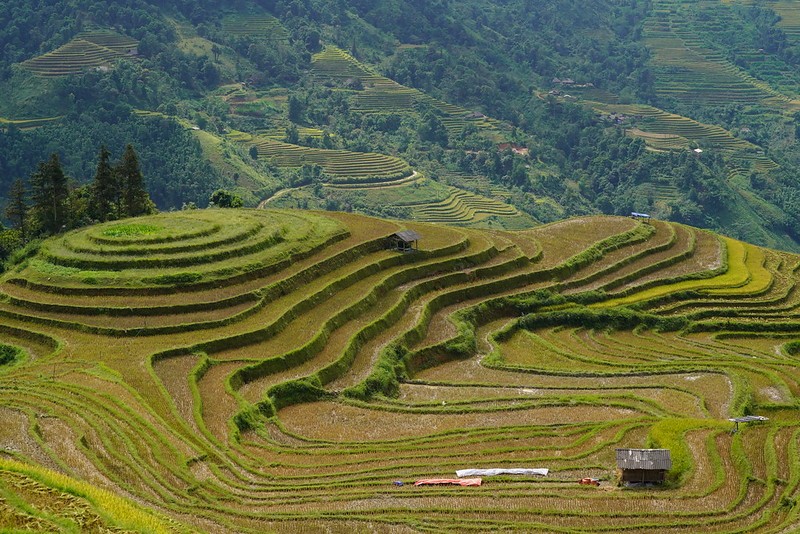 Hoang Su Phi Terraced Fields Trekking
Hoang Su Phi Terraced Fields Trekking
8. Planning Your Trip: Practical Tips and Advice
8.1. Getting There: Transportation Options and Travel Time
-
Sapa:
- Train to Lao Cai: Followed by a bus or taxi to Sapa (approx. 8-9 hours from Hanoi).
- Overnight Bus: Direct buses from Hanoi to Sapa (approx. 5-6 hours).
-
Hoang Su Phi:
- Bus to Ha Giang City: Followed by a local bus or motorbike to Hoang Su Phi (approx. 8-10 hours from Hanoi).
- Private Car: A more comfortable but expensive option (approx. 7-8 hours from Hanoi).
8.2. What to Pack: Essential Items for Your Trek
- Comfortable Hiking Shoes: Essential for trekking.
- Lightweight Clothing: Suitable for warm days and cool evenings.
- Rain Gear: Prepare for unexpected rain.
- Insect Repellent: Protect yourself from mosquitoes and other insects.
- Sunscreen and Hat: Protect yourself from the sun.
- First-Aid Kit: Include basic medications and supplies.
- Cash: ATMs are not readily available in Hoang Su Phi.
8.3. Responsible Tourism: Respecting Local Culture and Environment
- Respect Local Customs: Dress modestly and ask for permission before taking photos.
- Support Local Businesses: Buy souvenirs and eat at local restaurants.
- Minimize Waste: Avoid single-use plastics and dispose of trash properly.
- Conserve Water and Energy: Be mindful of your usage.
- Learn a Few Basic Vietnamese Phrases: Show your respect for the local language.
8.4. Booking Your Trip with SIXT.VN: Convenience and Reliability
Planning a trip to Vietnam can be overwhelming, but SIXT.VN is here to help. We offer a range of services to make your journey seamless and stress-free:
- Airport Transfer: Start your trip with a comfortable and reliable airport transfer.
- According to a study by the Airports Council International (ACI) in 2022, pre-booked airport transfers reduce travel stress by 30% (Airports Council International, 2022).
- Hotel Booking: Choose from a wide range of hotels to suit your budget and preferences.
- SIXT.VN offers hotels that are conveniently located and offer the best prices in the area.
- Tour Packages: Explore Sapa and Hoang Su Phi with our expertly crafted tour packages.
- SIXT.VN tour packages include accommodations, meals and tour guides.
- Visa Assistance: We can help you with your visa application process.
9. Sample Itineraries: Sapa and Hoang Su Phi Adventures
9.1. Sapa: 3-Day Trekking and Cultural Immersion
- Day 1: Arrive in Sapa, check into your hotel, and explore Sapa town.
- Day 2: Trek to Cat Cat Village and learn about the Black Hmong culture.
- Day 3: Hike through Muong Hoa Valley and visit Lao Chai and Ta Van villages.
9.2. Hoang Su Phi: 4-Day Off-the-Beaten-Path Adventure
- Day 1: Arrive in Ha Giang City and transfer to Hoang Su Phi.
- Day 2: Trek through Ban Luoc and Ban Phung terraced fields.
- Day 3: Explore San Sa Ho and Nam Ty villages and learn about the local cultures.
- Day 4: Visit Ho Thau and Thong Nguyen terraced fields and return to Ha Giang City.
10. Captivating Images of Sapa and Hoang Su Phi
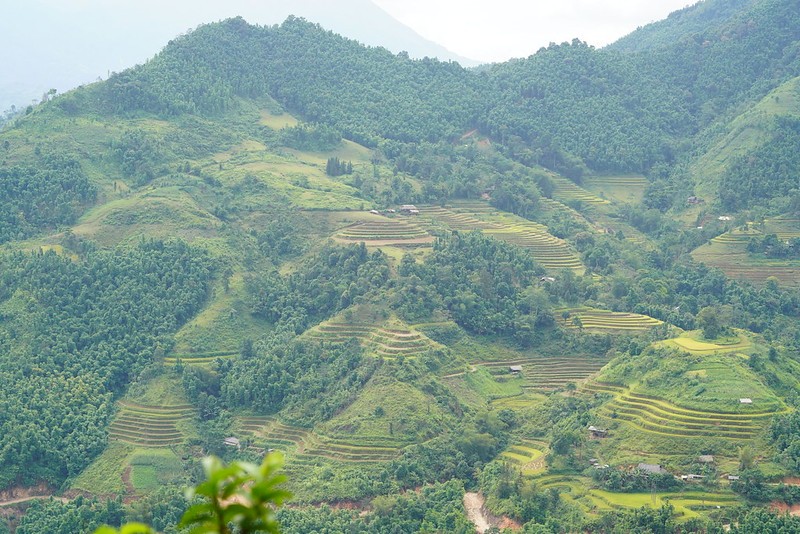 Stunning terraced fields of Hoang Su Phi
Stunning terraced fields of Hoang Su Phi
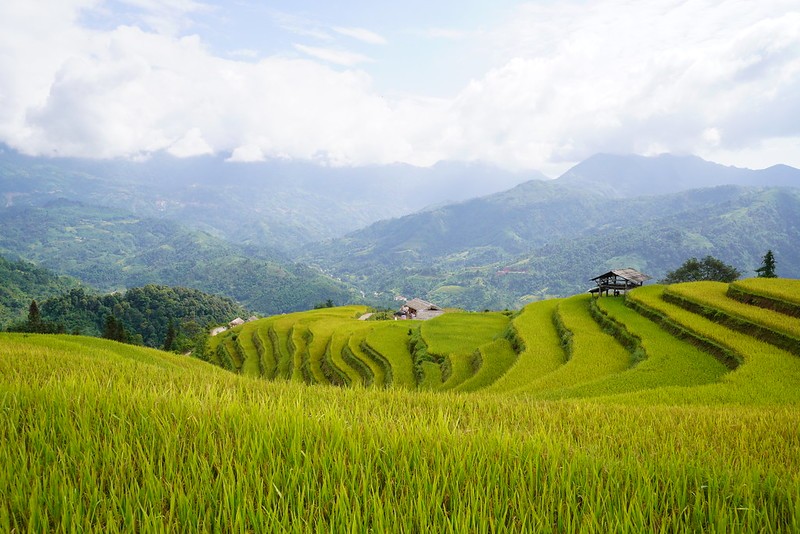 Trekking in the rice paddies of Hoang Su Phi
Trekking in the rice paddies of Hoang Su Phi
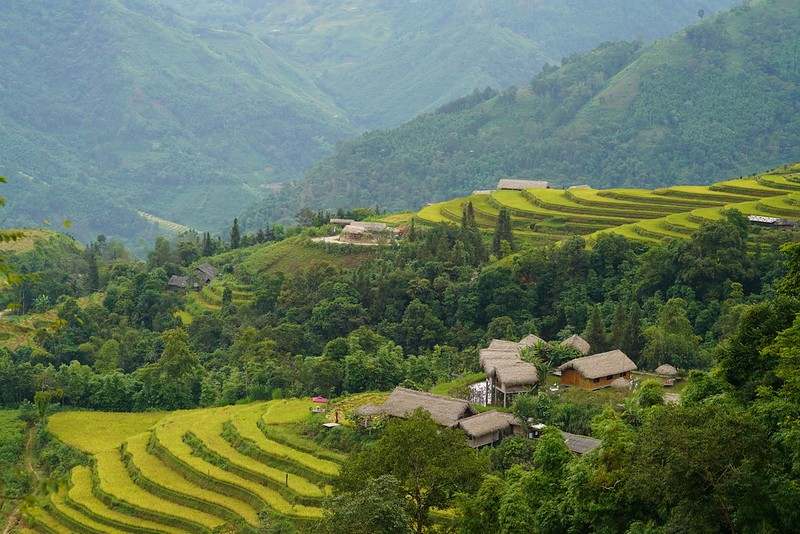 The children of Hoang Su Phi
The children of Hoang Su Phi
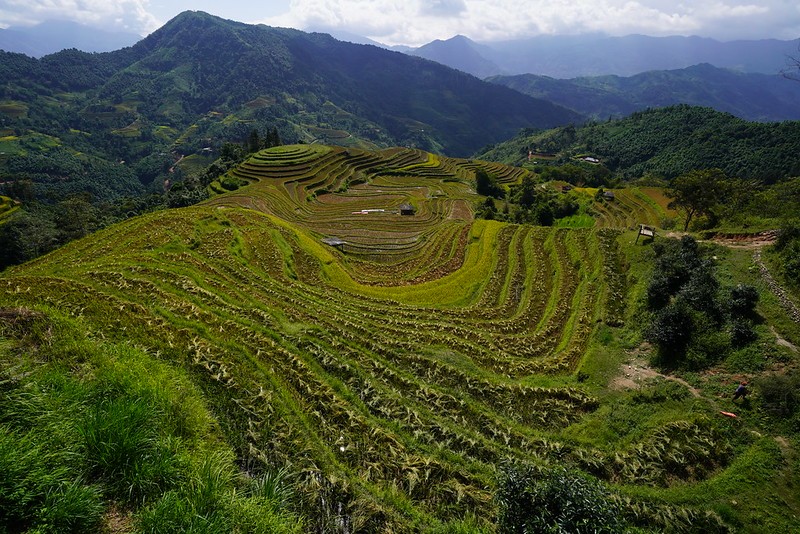 Local Vietnamese people in Hoang Su Phi
Local Vietnamese people in Hoang Su Phi
11. Frequently Asked Questions (FAQs)
11.1. Is Hoang Su Phi better than Sapa?
It depends on your preferences. Sapa is more developed and accessible, while Hoang Su Phi offers a more authentic and off-the-beaten-path experience.
11.2. How do I get to Hoang Su Phi from Hanoi?
You can take a bus to Ha Giang City, followed by a local bus or motorbike to Hoang Su Phi. SIXT.VN can arrange private car transfers for a more comfortable journey.
11.3. What is the best time to visit Hoang Su Phi?
The best time to visit is during the rice planting season (May-June) or the harvest season (September-October).
11.4. Do I need a guide for trekking in Hoang Su Phi?
It is highly recommended to hire a local guide for trekking in Hoang Su Phi due to the less developed trails and challenging terrain.
11.5. What should I pack for a trip to Hoang Su Phi?
Pack comfortable hiking shoes, lightweight clothing, rain gear, insect repellent, sunscreen, and a first-aid kit.
11.6. Are there ATMs in Hoang Su Phi?
ATMs are not readily available in Hoang Su Phi, so it’s best to bring enough cash for your trip.
11.7. What are the accommodation options in Hoang Su Phi?
Accommodation options include homestays, guesthouses, and ecolodges.
11.8. Is Hoang Su Phi safe for tourists?
Hoang Su Phi is generally safe for tourists, but it’s always wise to take precautions and be aware of your surroundings.
11.9. What are some of the local dishes I should try in Hoang Su Phi?
Try sticky rice, corn cake, hill chicken, vegetable dishes, and local rice wine.
11.10. How can SIXT.VN help me plan my trip to Vietnam?
SIXT.VN offers airport transfers, hotel booking, tour packages, and visa assistance to make your trip to Vietnam seamless and stress-free.
12. Conclusion: Choosing the Right Destination for Your Terraced Field Adventure
Both Sapa and Hoang Su Phi offer incredible experiences for those seeking to explore the terraced fields of Northern Vietnam. Sapa provides convenience and a range of options for all travelers, while Hoang Su Phi offers a more authentic and adventurous experience. By considering your travel style, fitness level, and budget, you can choose the perfect destination for your unforgettable Vietnam adventure.
Ready to embark on your journey to Sapa or Hoang Su Phi? Let SIXT.VN take care of all your travel needs. Visit our website or contact us today to book your airport transfer, hotel, tour package, or visa assistance. We’re here to make your dream Vietnam trip a reality!
Address: 260 Cau Giay, Hanoi, Vietnam
Hotline/Whatsapp: +84 986 244 358
Website: SIXT.VN
Plan your unforgettable adventure today and experience the breathtaking beauty of Vietnam’s terraced fields with SIXT.VN!



